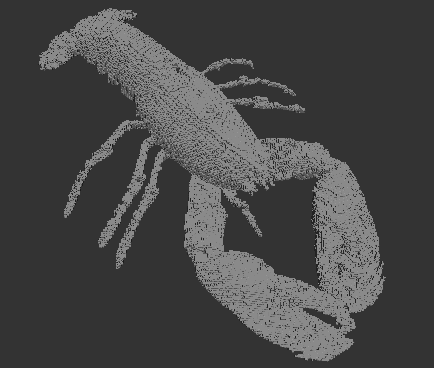Loading...
Searching...
No Matches
topology/volTrackBoundary.cpp
In many circumstances, it is better to use the presented graph structure of digital surfaces. For instance it may be used to find the surface just by searching it by adjacencies. This process is called tracking. This is done for you by static method Surfaces::trackBoundary.
On the lobser.vol volume, volTrackBoundary.cpp extracts 148364 surfels in 351ms.
* # Commands * $ ./examples/topology/volTrackBoundary ../examples/samples/lobster.vol 50 255 *

Digital surface that is the boundary of a (6,18)-connected component in image lobst* er.vol, extracted by tracking from an initial surfel in 351ms.
#include <iostream>
#include <queue>
#include "DGtal/base/Common.h"
#include "DGtal/io/viewers/PolyscopeViewer.h"
#include "DGtal/io/readers/VolReader.h"
#include "DGtal/io/Color.h"
#include "DGtal/images/ImageSelector.h"
#include "DGtal/images/imagesSetsUtils/SetFromImage.h"
#include "DGtal/shapes/Shapes.h"
#include "DGtal/helpers/StdDefs.h"
#include "DGtal/topology/helpers/Surfaces.h"
using namespace std;
using namespace DGtal;
using namespace Z3i;
{
std::cerr << "Usage: " << argv[ 0 ] << " <fileName.vol> <minT> <maxT>" << std::endl;
std::cerr << "\t - displays the boundary of the shape stored in vol file <fileName.vol>." << std::endl;
std::cerr << "\t - voxel v belongs to the shape iff its value I(v) follows minT <= I(v) <= maxT." << std::endl;
}
{
if ( argc < 4 )
{
usage( argc, argv );
return 1;
}
std::string inputFilename = argv[ 1 ];
unsigned int minThreshold = atoi( argv[ 2 ] );
unsigned int maxThreshold = atoi( argv[ 3 ] );
DigitalSet set3d (image.domain());
minThreshold, maxThreshold);
KSpace ks;
bool space_ok = ks.init( image.domain().lowerBound(),
image.domain().upperBound(), true );
if (!space_ok)
{
return 2;
}
MySurfelAdjacency surfAdj( true ); // interior in all directions.
KSpace::SCellSet boundary;
Surfaces<KSpace>::trackBoundary( boundary, ks,
surfAdj,
set3d, bel );
PolyscopeViewer<> viewer( ks );
viewer << Color( 128, 128, 128 );
unsigned long nbSurfels = 0;
for ( KSpace::SCellSet::const_iterator it = boundary.begin(),
it_end = boundary.end(); it != it_end; ++it, ++nbSurfels )
viewer << *it;
viewer.show();
return 0;
}
Definition PolyscopeViewer.h:56
Aim: A utility class for constructing surfaces (i.e. set of (n-1)-cells).
Definition Surfaces.h:79
Aim: Represent adjacencies between surfel elements, telling if it follows an interior to exterior ord...
Definition SurfelAdjacency.h:66
void beginBlock(const std::string &keyword="")
std::ostream & error()
std::ostream & info()
double endBlock()
DGtal is the top-level namespace which contains all DGtal functions and types.
Definition ClosedIntegerHalfPlane.h:49
Trace trace
STL namespace.
Aim: Define utilities to convert a digital set into an image.
Definition SetFromImage.h:64
Image image(domain)
ImageContainerBySTLVector< Domain, Value > Image
Definition testSimpleRandomAccessRangeFromPoint.cpp:45